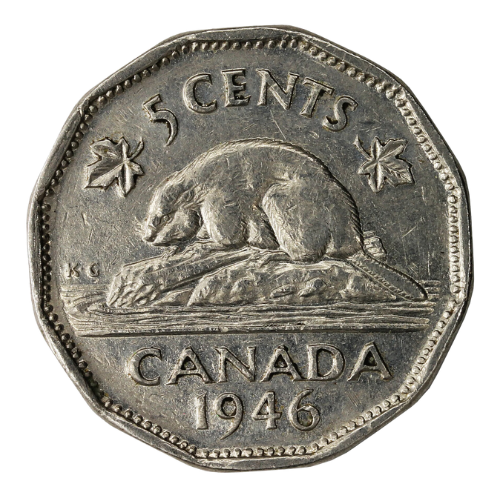Last updated on February 19th, 2025 at 08:53 pm
Last Updated on February 19, 2025 Posted by Colonial Acres Coins
Welcome back to our Canadian Decimal Coin series! Last month, we explored the story behind the Canadian penny, a fascinating deep-dive into its historical roots and lasting impact. This time, we’re shifting focus to the Canadian 5 cent coin—a piece of Canadian history that’s packed with rich stories, beloved designs, and exciting collectible opportunities. Far from being just another coin in your pocket, this little treasure is a window into Canada’s evolving heritage.
If you’ve ever wondered how the Canadian nickel evolved or how the iconic beaver became its face, you’re in for a treat. This guide will take you through the history, design, and must-have collectible nickels every coin enthusiast should know about.
The 5 Cent Canadian Coin Historical Timeline
The 5 cent Canadian coin history dates back to 1858, when Canada introduced its first decimal currency. These earliest coins were small but mighty, made of silver and affectionately nicknamed “fish scales.” Measuring just 15.5 mm in diameter, these coins packed a surprising amount of purchasing power into their petite frames. (1)
The Silver Era (1858–1921)
The first nickel coins, minted from 1858 to 1921, were composed of sterling silver (92.5% silver and 7.5% copper) and were highly sought after. These tiny coins were practical for the time but often easy to misplace due to their compact size. Over time, their composition and size would evolve with economic demands.
Rising silver prices in the early 20th century made producing these coins increasingly expensive. 1922 marked a major turning point when the nickel transitioned to pure nickel composition, ushering in the larger, more durable “nickel” that collectors know today. This change made practical sense for Canada, as it was a leading metal producer at the time.(1)
Wartime Innovations (1942–1945)
The demands of World War II brought major changes to the five-cent coin. With nickel deemed critical for munitions, coins were produced using Tombac, a brass alloy, from 1942 to 1943. These Tombac coins are instantly recognizable for their golden hue. By 1944, chrome-plated steel became the material of choice, providing an affordable yet striking alternative.
These wartime transitions weren’t just a response to demand—they also symbolized the resilience of Canada during challenging times.
Modern Changes (1982–Present)
The composition of the nickel shifted again in 1982 due to rising metal costs, transitioning from pure nickel to a mix of copper and nickel, and later to nickel-plated steel in 2000. Despite these changes, the coin is still affectionately called a “nickel,” a nod to its historic roots.(1)
The Iconic Nickel Design Over the Years
The design of the nickel has undergone various changes over the years, reflecting shifts in style and symbolism. However, one element has remained consistent for over 85 years—the iconic image of the beaver. As a symbol of hard work and resourcefulness, the beaver has become a defining feature of the nickel, standing the test of time through the coin’s many design updates.
Design Through the Decades: From Silver Boughs to Nickel Leaves
- 1858: The design features two crossed maple boughs with 21 maple leaves, surrounded by a wide rim with long denticles. The date is displayed in small, widely spaced digits. Nicknamed “fish scales” for its small size, it measures just 15.5 mm in diameter and is made of silver.
- 1909-1910: There are two variations of maple leaves on these coins: rounded leaves and pointed leaves, with a total of 22 maple leaves. The pointed leaves, resembling holly leaves, are accompanied by a narrow rim with short denticles. Some 1909 coins featured a bow tie shape on the crown, while others displayed a small cross. On 1910 coins with pointed leaves, the crown always showed a cross over the bow tie.
- 1930: the Canadian five-cent coin featured a two maple leaves design and was larger in size with a diameter of 21.21 mm. It was made of pure nickel and had no rim denticles or beads. The reverse side displayed the inscription “CANADA FIVE 5 CENTS 1930.”
- 1922-1936: The coin features a two-maple-leaf design and is significantly larger in size compared to previous silver coins. Made of pure nickel, it lacks any dots or denticles around the rim. The word “CANADA” is inscribed at the top, with “FIVE 5 CENTS” below and the date at the bottom. In certain years (1922, 1929, 1932, 1934, 1936), variations can be found in the position of the ‘S’ in ‘CENTS’ relative to the rim.
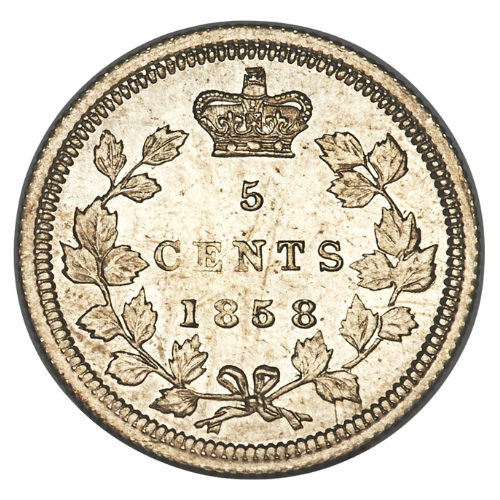
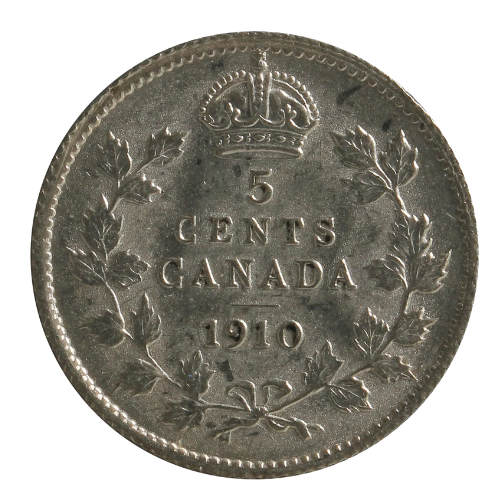
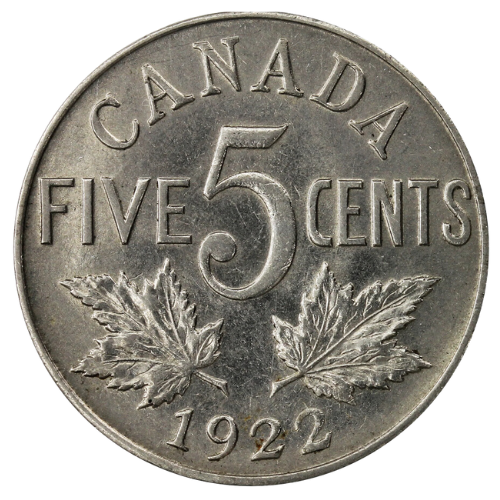
Enter the Beaver – A Canadian Icon
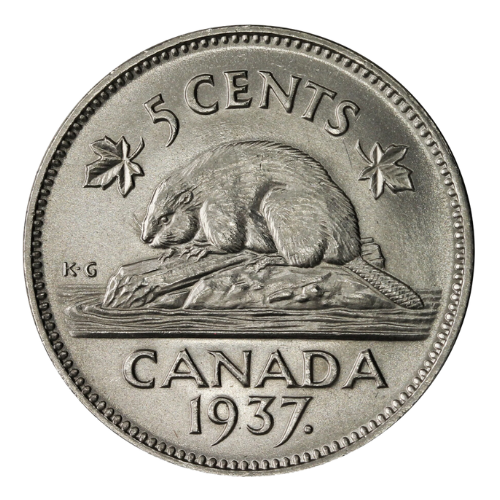 The most famous and enduring design made its debut in 1937. Designed by artist G.E. Kruger-Gray, the image of a beaver sitting atop a rock in a stream became synonymous with the nickel. A symbol of industry, hard work, and Canada’s rich fur-trading history, the beaver remains front and center on nickels to this day.
The most famous and enduring design made its debut in 1937. Designed by artist G.E. Kruger-Gray, the image of a beaver sitting atop a rock in a stream became synonymous with the nickel. A symbol of industry, hard work, and Canada’s rich fur-trading history, the beaver remains front and center on nickels to this day.
Unique Shapes and Commemorative Designs
During the 1940s, nickels took on a dodecagonal (12-sided) shape to help distinguish them from pennies. Though originally introduced as a wartime measure, this shape continued until 1963, becoming a snapshot of Canadian ingenuity.
The nickel has also featured numerous commemorative designs. One of the most popular is the 1967 Centennial Nickel, adorned with Alex Colville’s image of a hopping hare, created to celebrate Canada’s 100th anniversary of Confederation.
Other standouts include the 1943-1945 Victory Nickels, with their bold “V” motif and patriotic Morse code message, as well as the 1951 Nickel Refinery commemorative coin that highlights Canada’s role in the global nickel industry.
Condition and Grading
The value of a collectible coin is largely influenced by its condition, with coins in better shape often fetching significantly higher prices. Mint-state pieces, which show no visible wear and retain all their original details, are particularly sought after by collectors and can command premium prices. To accurately assess the condition and value of your coins, it’s highly recommended to utilize professional grading services. These services provide an expert evaluation of your coin’s quality, helping you determine its true worth and maximize its potential value in the marketplace. Proper grading can also give buyers confidence, making your coins stand out in a competitive market.
Add the Canadian 5 Cent Coin to Your Collection
Every five-cent coin tells a story—of Canada’s evolving economy, its artistic innovation, or resilience during tough times. From the tiny silver “fish scales” of centuries past to the beaver gracing today’s steel coins, the Canadian 5 cent coin is a tangible symbol of the country’s spirit.
Whether you’re drawn to rare collectibles or simply love a good historical story, Colonial Acres Coins has something for everyone. Explore our extensive selection of vintage and modern nickels, and start your own collection of Canada’s most remarkable coins.
Visit us today to uncover hidden treasures and hold a piece of Canadian history in your hands. Happy collecting!
Citations:
- Bank of Canada Museum. 2019, January 3. Unpacking the Collection 11. https://www.bankofcanadamuseum.ca/2019/01/unpacking-the-collection-11/
- Royal Canadian Mint. 2022, March 6. The History Behind the 5-cent Coin. https://www.mint.ca/en/blog/2022-03-5-stories-every-canadian-should-know-5-cent

